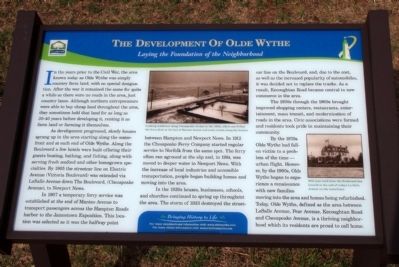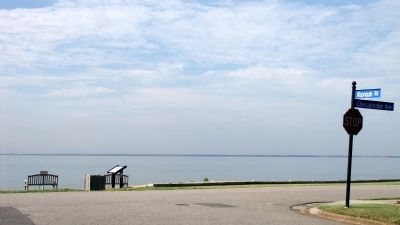Wythe in Hampton, Virginia — The American South (Mid-Atlantic)
The Development Of Olde Wythe
Laying the Foundation of the Neighborhood
As development progressed, slowly houses sprang up in the area starting along the waterfront and at each end of Olde Wythe. Along the Boulevard a few hotels were built offering their guests boating, bathing, and fishing, along with serving fresh seafood and other home own specialties. By 1905 the street car line on Electric Avenue (Victoria Boulevard) was extended via LaSalle Avenue down The Boulevard, (Chesapeake Avenue), to Newport News.
In 1907 a temporary ferry service was established at the end of Manteo Avenue to transport passengers across the Hampton Roads harbor to the Jamestown Exposition. This location was selected as it was the halfway point between Hampton and Newport News. In 1912 the Chesapeake Ferry Company started regular service to Norfolk from the same spot. The ferry often ran aground at the slip and, in 1914, was moved to deeper water in Newport News. With the increase of local industries and accessible transportation, people began building homes and moving into the area.
In the 1920s houses, businesses, and churches continued to spring up throughout the area. The storm of 1933 destroyed the streetcar line on the Boulevard, and, due to the cost, as well as the increased popularity of automobiles, it was decided not to replace the tracks. As a result, Kecoughtan Road became central to new commerce in the area.
The 1930s through the 1960s brought improved shopping centers, restaurants, entertainment, mass transit, and modernization of roads in the area. Civic associations were formed and residents took pride in maintaining their community.
By the 1970s Olde Wythe had fallen victim to a problem of the time – urban flight. However, by the 1990s, Olde Wythe began to experience a renaissance with new families moving into the area and homes being refurbished. Today, Olde Wythe, defined as the area between LaSalle Avenue, Pear Avenue, Kecoughtan Road and Chesapeake Avenue, is a thriving neighborhood which its residents are proud to call home.
Bringing History to Life
For more neighborhood information visit: www.oldewythe.com
For more visitor information visit: www.VisitHampton.com
In partnership with Virginia Civil War Trails, www.civilwartrails.org
Erected by Olde Wythe Neighborhood Association.
Topics. This historical marker is listed in these topic lists: Industry & Commerce • Railroads & Streetcars • Roads & Vehicles • Settlements & Settlers • Waterways & Vessels. A significant historical year for this entry is 1905.
Location. 37° 0.102′ N, 76° 21.863′ W. Marker is in Hampton, Virginia. It is in Wythe. Marker is at the intersection of Chesapeake Avenue (Virginia Route 167) and Algonquin Road, on the left when traveling south on Chesapeake Avenue. Touch for map. Marker is in this post office area: Hampton VA 23661, United States of America. Touch for directions.
Other nearby markers. At least 8 other markers are within walking distance of this marker. Olde Wythe During Colonial Times (about 500 feet away, measured in a direct line); Fertile Hunting Grounds For The Indians (about 500 feet away); Admiral Sir George Cockburn on the Chesapeake / The War of 1812 (approx. 0.2 miles away); Hampton Roads – World’s Greatest Harbor (approx. 0.2 miles away); Stalemate in Hampton Roads (approx. 0.2 miles away); First Battle of Ironclads (approx. 0.2 miles away); The Hampton Roads Golf And Country Club (approx. 0.3 miles away); First Church at Kecoughtan (approx. 0.4 miles away). Touch for a list and map of all markers in Hampton.
More about this marker. On the center is a photo with the caption, "Looking southwest along Chesapeake Avenue in the 1920s, where you'll find the ferry dock at the end of Mantoe Avenue and trolly tracks along the harbor."
On the lower right is a "1904 postcard from the Boulevard Inn located at the end of todays La Salle Avenue on the waterfront."
Also see . . .
1. Memories and History of Hampton Virginia’s Olde Wythe Neighborhood. (Submitted on August 2, 2010, by Bernard Fisher of Richmond, Virginia.)
2. Hampton Convention & Visitor Bureau. (Submitted on August 2, 2010, by Bernard Fisher of Richmond, Virginia.)
3. Virginia Civil War Trails. (Submitted on August 2, 2010, by Bernard Fisher of Richmond, Virginia.)
Credits. This page was last revised on February 1, 2023. It was originally submitted on August 2, 2010, by Bernard Fisher of Richmond, Virginia. This page has been viewed 1,062 times since then and 62 times this year. Photos: 1, 2. submitted on August 2, 2010, by Bernard Fisher of Richmond, Virginia.

